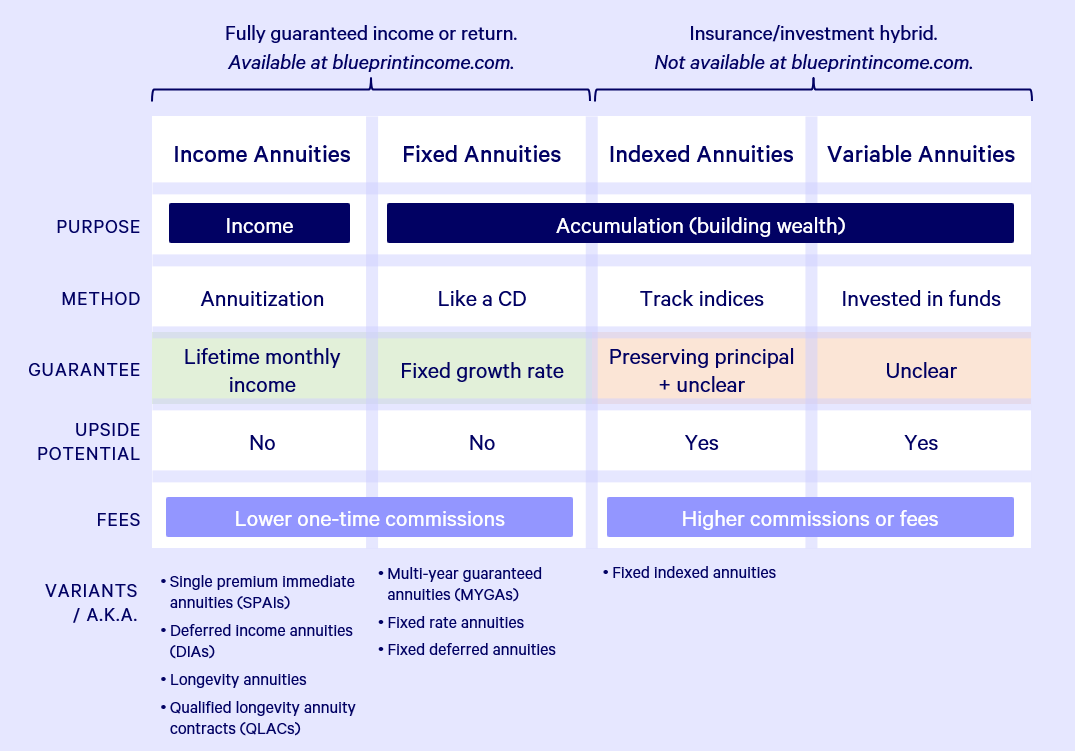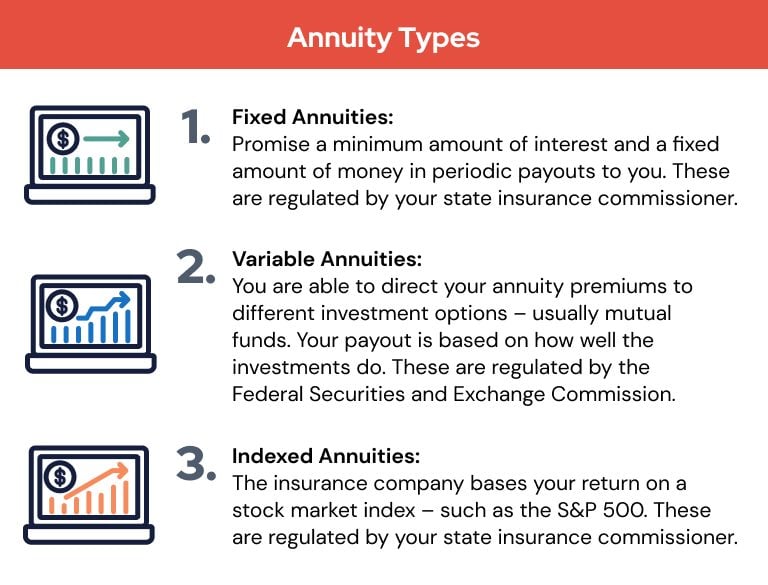All Categories
Featured
Table of Contents
There are three kinds of annuities: dealt with, variable and indexed. With a repaired annuity, the insurer ensures both the rate of return (the rate of interest rate) and the payout to the investor. The rates of interest on a taken care of annuity can change gradually. Often the rate of interest is fixed for a variety of years and after that changes regularly based upon existing prices.
With a deferred fixed annuity, the insurance company accepts pay you no less than a specified interest rate as your account is expanding. With an instant fixed annuityor when you "annuitize" your deferred annuityyou get a predetermined set quantity of money, normally on a month-to-month basis (similar to a pension).
While a variable annuity has the advantage of tax-deferred growth, its yearly expenses are likely to be much higher than the expenditures of a normal mutual fund. And, unlike a taken care of annuity, variable annuities do not provide any warranty that you'll make a return on your financial investment. Instead, there's a risk that you can in fact lose money.
Exploring Variable Annuity Vs Fixed Annuity Key Insights on Fixed Index Annuity Vs Variable Annuity Defining Variable Annuity Vs Fixed Annuity Advantages and Disadvantages of Different Retirement Plans Why What Is Variable Annuity Vs Fixed Annuity Can Impact Your Future Annuities Variable Vs Fixed: Simplified Key Differences Between Fixed Annuity Vs Variable Annuity Understanding the Risks of Long-Term Investments Who Should Consider Strategic Financial Planning? Tips for Choosing Fixed Income Annuity Vs Variable Annuity FAQs About Planning Your Financial Future Common Mistakes to Avoid When Choosing Indexed Annuity Vs Fixed Annuity Financial Planning Simplified: Understanding Your Options A Beginner’s Guide to Annuities Variable Vs Fixed A Closer Look at How to Build a Retirement Plan
Because of the complexity of variable annuities, they're a leading source of financier complaints to FINRA. Prior to buying a variable annuity, very carefully reviewed the annuity's program, and ask the individual offering the annuity to describe all of the product's features, cyclists, prices and limitations. You need to likewise know just how your broker is being compensated, including whether they're obtaining a payment and, if so, just how much.
Indexed annuities are complicated monetary tools that have attributes of both repaired and variable annuities. Indexed annuities typically offer a minimum guaranteed rate of interest incorporated with a rate of interest rate linked to a market index. Numerous indexed annuities are tied to broad, widely known indexes like the S&P 500 Index. Some use various other indexes, consisting of those that stand for other segments of the market.
Comprehending the functions of an indexed annuity can be confusing. There are a number of indexing methods firms use to calculate gains and, as a result of the selection and intricacy of the techniques used to credit passion, it's difficult to compare one indexed annuity to one more. Indexed annuities are generally classified as one of the following 2 types: EIAs provide an assured minimum rates of interest (generally at the very least 87.5 percent of the premium paid at 1 to 3 percent rate of interest), as well as an extra rate of interest tied to the performance of one or even more market index.

With variable annuities, you can spend in a range of safety and securities including stock and bond funds. Supply market performance establishes the annuity's value and the return you will get from the money you invest.
Comfortable with fluctuations in the stock market and desire your investments to keep rate with rising cost of living over a long duration of time. Youthful and intend to prepare economically for retirement by gaining the gains in the stock or bond market over the long-term.
As you're accumulating your retirement financial savings, there are many methods to extend your money. can be especially beneficial cost savings tools because they guarantee an earnings quantity for either a set duration of time or for the remainder of your life. Dealt with and variable annuities are 2 choices that offer tax-deferred growth on your contributionsthough they do it in various ways.
Decoding How Investment Plans Work A Closer Look at Immediate Fixed Annuity Vs Variable Annuity What Is the Best Retirement Option? Pros and Cons of Fixed Vs Variable Annuity Pros Cons Why Choosing the Right Financial Strategy Can Impact Your Future How to Compare Different Investment Plans: Simplified Key Differences Between Annuities Variable Vs Fixed Understanding the Key Features of What Is A Variable Annuity Vs A Fixed Annuity Who Should Consider Strategic Financial Planning? Tips for Choosing the Best Investment Strategy FAQs About Variable Annuities Vs Fixed Annuities Common Mistakes to Avoid When Planning Your Retirement Financial Planning Simplified: Understanding Your Options A Beginner’s Guide to Smart Investment Decisions A Closer Look at How to Build a Retirement Plan
A gives a guaranteed passion price. Your agreement worth will enhance due to the amassing of ensured passion profits, indicating it will not shed value if the market experiences losses.
Your variable annuity's investment performance will impact the dimension of your nest egg. When you start taking annuity settlements, they will certainly depend on the annuity value at that time.
Market losses likely will cause smaller sized payouts. Any passion or various other gains in either sort of contract are protected from current-year tax; your tax responsibility will come when withdrawals begin. Let's consider the core functions of these annuities so you can choose just how one or both may fit with your general retired life technique.

A fixed annuity's value will not decrease because of market lossesit's constant and stable. On the various other hand, variable annuity values will certainly rise and fall with the efficiency of the subaccounts you elect as the markets rise and drop. Earnings on your fixed annuity will extremely depend upon its gotten rate when acquired.
Conversely, payout on a dealt with annuity purchased when interest rates are low are more probable to pay earnings at a lower price. If the rate of interest price is ensured for the size of the contract, earnings will certainly continue to be constant no matter the markets or price activity. A set rate does not suggest that taken care of annuities are safe.
While you can not come down on a fixed price with a variable annuity, you can select to buy conventional or hostile funds tailored to your danger level. More conservative investment alternatives, such as temporary bond funds, can aid lower volatility in your account. Given that repaired annuities supply a set price, reliant upon existing rates of interest, they do not supply that same flexibility.
Analyzing Strategic Retirement Planning A Closer Look at Deferred Annuity Vs Variable Annuity Defining Fixed Annuity Vs Variable Annuity Benefits of Choosing the Right Financial Plan Why Choosing the Right Financial Strategy Is a Smart Choice Tax Benefits Of Fixed Vs Variable Annuities: A Complete Overview Key Differences Between Fixed Vs Variable Annuities Understanding the Rewards of Choosing Between Fixed Annuity And Variable Annuity Who Should Consider Strategic Financial Planning? Tips for Choosing Fixed Vs Variable Annuities FAQs About Planning Your Financial Future Common Mistakes to Avoid When Planning Your Retirement Financial Planning Simplified: Understanding Your Options A Beginner’s Guide to Smart Investment Decisions A Closer Look at Pros And Cons Of Fixed Annuity And Variable Annuity
:max_bytes(150000):strip_icc()/VariableAnnuitization-asp-v1-5dedf8fee4694d8dacd2ac7eb7b0757e.jpg)
You potentially can gain extra lengthy term by taking additional risk with a variable annuity, however you could likewise lose money. While dealt with annuity agreements prevent market danger, their compromise is much less development possibility.
Investing your variable annuity in equity funds will certainly give even more potential for gains. The costs connected with variable annuities might be higher than for various other annuities.
The insurance coverage firm might enforce surrender fees, and the IRS might impose a very early withdrawal tax obligation penalty. They begin at a specific percent and after that decrease over time.
Annuity revenues go through a 10% very early withdrawal tax obligation charge if taken before you reach age 59 unless an exception uses. This is imposed by the IRS and relates to all annuities. Both dealt with and variable annuities supply options for annuitizing your equilibrium and turning it right into an ensured stream of lifetime earnings.
Highlighting the Key Features of Long-Term Investments Everything You Need to Know About Financial Strategies What Is Annuities Variable Vs Fixed? Features of Fixed Income Annuity Vs Variable Annuity Why What Is A Variable Annuity Vs A Fixed Annuity Matters for Retirement Planning Annuity Fixed Vs Variable: Explained in Detail Key Differences Between Pros And Cons Of Fixed Annuity And Variable Annuity Understanding the Rewards of Long-Term Investments Who Should Consider Strategic Financial Planning? Tips for Choosing the Best Investment Strategy FAQs About Planning Your Financial Future Common Mistakes to Avoid When Planning Your Retirement Financial Planning Simplified: Understanding Retirement Income Fixed Vs Variable Annuity A Beginner’s Guide to Deferred Annuity Vs Variable Annuity A Closer Look at Fixed Index Annuity Vs Variable Annuities
You may determine to utilize both taken care of and variable annuities. If you're picking one over the various other, the differences issue: A might be a far better option than a variable annuity if you have a much more traditional danger resistance and you seek foreseeable passion and major defense. A might be a better option if you have a greater danger resistance and desire the capacity for long-lasting market-based development.
There are different kinds of annuities that are designed to offer different objectives. A fixed annuity warranties payment of a set amount for the term of the agreement.
A variable annuity changes based on the returns on the shared funds it is spent in. A prompt annuity starts paying out as quickly as the buyer makes a lump-sum settlement to the insurance company.
Annuities' returns can be either dealt with or variable. With a repaired annuity, the insurance policy business ensures the customer a details settlement at some future date.
Table of Contents
Latest Posts
Exploring the Basics of Retirement Options Key Insights on Your Financial Future What Is Fixed Vs Variable Annuity Pros And Cons? Benefits of Annuities Fixed Vs Variable Why Choosing the Right Financi
Decoding How Investment Plans Work Key Insights on Fixed Annuity Or Variable Annuity Defining Fixed Income Annuity Vs Variable Growth Annuity Advantages and Disadvantages of Annuities Variable Vs Fixe
Breaking Down Pros And Cons Of Fixed Annuity And Variable Annuity A Comprehensive Guide to Fixed Vs Variable Annuities Breaking Down the Basics of Deferred Annuity Vs Variable Annuity Pros and Cons of
More
Latest Posts